
Kingston, NY, Broadway at the Railway Crossing
Kingston Streets
Winter 2014
|
Imagine the snarl of commuters (and their vehicles) if the rail crossing on Broadway in Kingston stalled them every day. Fortunately, Broadway now dips below the tracks and you zip through unencumbered by rail schedules. The trolley in the postcard image is gone, but you can still see trolleys at the Trolley Museum in the Rondout—check out its winter schedule for a ride. Many of the buildings in these pictures were razed or have been renovated, but if you take the print edition of this article with you and stroll around this still beautiful city, you will understand what a vibrant, wealthy, county-center it was and you can imagine life in the early 1900s. 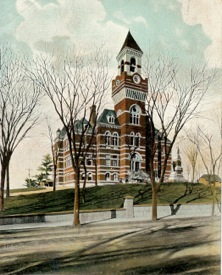 The City Hall, image circa 1907. Renovation of City Hall in the late 1990s makes it a great place to start your tour. According to Kingston, A Tribute by Alphonso Clearwater, then City Historian, in a 1929 booklet, “Its (City Hall’s) general characteristics are those of the celebrated Palazzio Vechio of Florence, Italy.” Clearwater describes the Hall’s interior details with its candle lighting and the frieze of history shaping characters and events encircling the Council Room.
Here is Main Street and at the left of the card is the Kirkland Hotel. The hotel was lovingly restored and is used today as offices. Other buildings on that side of the street were razed. In the same image, the red brick building at the far end of the street, really at the intersection with Fair Street, is the Burgevin Building that still stands. The County Office Building’s Mansard roof peeks out just before Fair Street but can be seen more clearly in the 1936 image below. Most buildings seen here on the left of Main were razed to build the current “glass menagerie” office building, and parking lot we see today.
“Those distinguished naturalists, John Burroughs and N.S. Shaler, both said to me that the selection of hard maple, white elm and sycamore (Button Ball) as shade trees of our streets, had given to Kingston a distinction rarely found in America, east of the immediate Atlantic seaboard. Of the white elm there is a magnificent specimen at the north east corner of the First (Old) Dutch Church yard, and of the sycamore a superb example at the Laboratory building on Crown Street.” The elms succumbed to Dutch Elm Disease, but sycamore and maple still grace many Kingston streets. Once an exotic species to our area, the Ginko, has proven a hardy, beautiful, and fast growing replacement. Its yellow leaves in Fall give a striking accent to the many stone and brick buildings.
The statues, once about to be melted in a foundry, were saved and acquired through the efforts of the late Herbert Shultz of Loundsbury Street. The park’s three figures represent Peter Stuyvesant, who in 1660, negotiated a peace treaty with the Esopus Indians among his many other accomplishments; Henry Hudson, explorer; and George Clinton, Ulster County Clerk, twice NYS Governor, and Vice president under Jefferson and Madison. Clinton is considered among the founders of our nation. He is buried in the Old Dutch Church yard near the corner of Wall and Main Streets, Kingston.
Once slave, then an American icon, Sojourner Truth, stood before the bench in the Courthouse of Ulster County to demand the freedom of her son, taken south into slavery. Her eloquence was not to be denied. She went on to become a spokesperson for human rights and is immortalized in numerous statues including one in Port Ewen—not far from her birthplace—which shows her as a young woman resolutely walking, possibly away from her own bondage. United States Presidential candidate Alton B. Parker (of Esopus) served as Chief Judge of the Court of Appeals in Albany, but previously had served as a Supreme Court judge in this building. (Parker, a Democrat, lost his 1904 presidential bid to Teddy Roosevelt). George Sharpe was an attorney in the Courthouse for many years and lived at 1 Albany Avenue, where the Clinton Hotel is currently located. Visitors to his home included Presidents Grant and Arthur and General William Tucumseh Sherman. During the Civil War, Sharpe first served with the Ulster 20th, then as Col. with the Ulster 120th, which he formed and led. The Ulster 120th was one of the most important regiments in the Civil War and were involved in most of its major battles. They played a critical role at Gettysburg. In the original court building (burned by the British), the Constitutional Convention to adopt the NYS Constitution was held. According to Picturesque Ulster by Richard Lionel de Lisser (1896), Chief Justice John Jay opened the first court under the provincial government there.
|

 The Post Office building that once occupied the corner of Broadway and Grand Street, now a fast food outlet. Enough said.
The Post Office building that once occupied the corner of Broadway and Grand Street, now a fast food outlet. Enough said.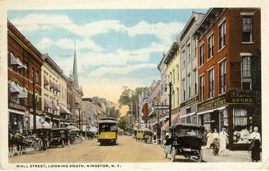 This postcard image is of Wall Street looking South. The trolley, horse-drawn carriages, and horseless carriages share the street. A sign perpendicular to the street reads “VanWagner,” and the one to its right reads “5 & 10 Cent Store” and may be Kresge’s (whose founder attended the Eastman Business College in Poughkeepsie) or Woolworth’s or perhaps a home grown “five and dime.” The card is postmarked 1918 and the message is “Spending part of our vacation in the mountains. Have been very busy resting.” Sent from Mrs. Gordon to Mrs. Griffin in NYC.
This postcard image is of Wall Street looking South. The trolley, horse-drawn carriages, and horseless carriages share the street. A sign perpendicular to the street reads “VanWagner,” and the one to its right reads “5 & 10 Cent Store” and may be Kresge’s (whose founder attended the Eastman Business College in Poughkeepsie) or Woolworth’s or perhaps a home grown “five and dime.” The card is postmarked 1918 and the message is “Spending part of our vacation in the mountains. Have been very busy resting.” Sent from Mrs. Gordon to Mrs. Griffin in NYC. The Central Fire Station as it appeared in the early 1900s. The first fire “apparatus” was a hand pump engine imported from England in 1757, according to Clearwater, and by 1929 the fire brigade boasted two American-LaFrance pumpers, an aerial truck, a hook and ladder, two combination chemical and hose trucks, two Ford hose trucks, one Chevrolet hose truck, one alarm truck and a Studebaker Chief’s car. He notes further that during 1928 …”the insurance loss due to fire was $33,350…”
The Central Fire Station as it appeared in the early 1900s. The first fire “apparatus” was a hand pump engine imported from England in 1757, according to Clearwater, and by 1929 the fire brigade boasted two American-LaFrance pumpers, an aerial truck, a hook and ladder, two combination chemical and hose trucks, two Ford hose trucks, one Chevrolet hose truck, one alarm truck and a Studebaker Chief’s car. He notes further that during 1928 …”the insurance loss due to fire was $33,350…”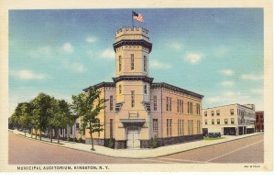 Civic buildings of distinction include the Municipal Auditorium, originally the NYS Armory, which today houses many events including the bi-annual postcard show where many of these cards were acquired. Gone now are many of the street trees pictured here and in other cards. Clearwater waxes eloquent on that subject with the following:
Civic buildings of distinction include the Municipal Auditorium, originally the NYS Armory, which today houses many events including the bi-annual postcard show where many of these cards were acquired. Gone now are many of the street trees pictured here and in other cards. Clearwater waxes eloquent on that subject with the following: The Academy Park trees provided shade to the visitors, while the Governor Clinton Hotel in the background provided hospitality and respite for tourists and business travelers. The pool is gone, but three large bronze statues of historically important men now provide grace and importance to the park. The park was once the site of the renown Kingston Academy (demolished in 1915). The Academy educated many of the men whose names, including Clearwater’s, are familiar to history fans.
The Academy Park trees provided shade to the visitors, while the Governor Clinton Hotel in the background provided hospitality and respite for tourists and business travelers. The pool is gone, but three large bronze statues of historically important men now provide grace and importance to the park. The park was once the site of the renown Kingston Academy (demolished in 1915). The Academy educated many of the men whose names, including Clearwater’s, are familiar to history fans.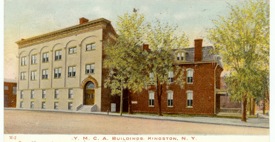 The original YMCA building at 507 Broadway was replaced with more modern facilities. Today, a women’s version (YWCA) is located on Clinton Avenue. The organizations in their early years sought to help maintain a “Christian” life for newly-minted city workers by providing the companionship and living spaces the transplants needed to adjust to their new environment and not fall prey to liquor or the unscrupulous. Today, the Kingston YMCA and YWCA provide many services for residents and visitors— health and fitness training, summer camps, swimming lessons, personal improvement programs, and child care, among others.
The original YMCA building at 507 Broadway was replaced with more modern facilities. Today, a women’s version (YWCA) is located on Clinton Avenue. The organizations in their early years sought to help maintain a “Christian” life for newly-minted city workers by providing the companionship and living spaces the transplants needed to adjust to their new environment and not fall prey to liquor or the unscrupulous. Today, the Kingston YMCA and YWCA provide many services for residents and visitors— health and fitness training, summer camps, swimming lessons, personal improvement programs, and child care, among others.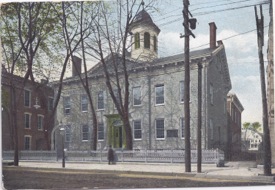 The jury summons, dreaded by some, actually provides a mini-history lesson by Commissioner of Jurors Paul O’Neill. His oration covers the notable events and people highlighting the history of the building in which jury selection is accomplished. Built in 1818 on the site of the original court house that was burned by the British in 1777, the “new” structure has been well preserved. It has an amazing story, delivered with enthusiasm and warmth, giving prospective jurors a sense of the ongoing history even their small role in our legal system provides. You feel the presence of women and men who helped shape not just our county, but our country. Consider just these few:
The jury summons, dreaded by some, actually provides a mini-history lesson by Commissioner of Jurors Paul O’Neill. His oration covers the notable events and people highlighting the history of the building in which jury selection is accomplished. Built in 1818 on the site of the original court house that was burned by the British in 1777, the “new” structure has been well preserved. It has an amazing story, delivered with enthusiasm and warmth, giving prospective jurors a sense of the ongoing history even their small role in our legal system provides. You feel the presence of women and men who helped shape not just our county, but our country. Consider just these few: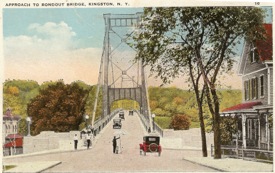 Standing in the middle of the intersection, the traffic control officer has all the important equipment of the day—a shading umbrella and a small stand. The Rondout Bridge was an important piece of infrastructure when it was completed in 1921. The building on the left side of the card is a home, and not visible in the postcard, but to the left of that was Temple Emanuel, the oldest Synagogue in the Hudson Valley (1854). House on right still stands. The bridge’s cables were supplied by the Roebling company, which also supplied the cables, designed, and built the Brooklyn Bridge which had been completed in 1888.
Standing in the middle of the intersection, the traffic control officer has all the important equipment of the day—a shading umbrella and a small stand. The Rondout Bridge was an important piece of infrastructure when it was completed in 1921. The building on the left side of the card is a home, and not visible in the postcard, but to the left of that was Temple Emanuel, the oldest Synagogue in the Hudson Valley (1854). House on right still stands. The bridge’s cables were supplied by the Roebling company, which also supplied the cables, designed, and built the Brooklyn Bridge which had been completed in 1888. When the West Shore Rail Line went into service in 1880s, it changed the face and pace of Kingston. At the time it was passenger and freight. Since 1959 there has been no passengers service, but more than 27 trains each day supply all manner of materials and food to multiple cities. And none of them make you stop on Broadway as they would have at the time of the image heading this article.
When the West Shore Rail Line went into service in 1880s, it changed the face and pace of Kingston. At the time it was passenger and freight. Since 1959 there has been no passengers service, but more than 27 trains each day supply all manner of materials and food to multiple cities. And none of them make you stop on Broadway as they would have at the time of the image heading this article.